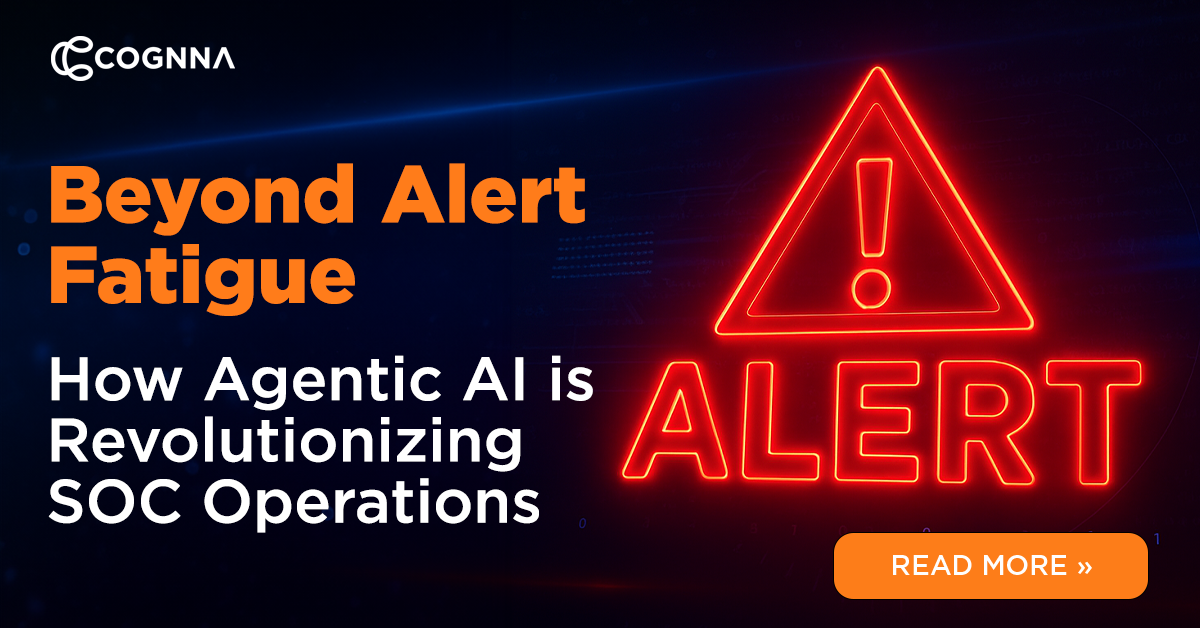Beyond Alert Fatigue: How Agentic AI is Revolutionizing SOC Operations

The Tsunami of Alerts: A Day in the Life of a SOC Analyst
Imagine starting your workday only to be immediately bombarded by a relentless stream of security alerts. System notifications ping incessantly, email inboxes overflow with warnings, and dashboards flash red with potential threats. This isn't a scene from a dystopian movie; it's the daily reality for many Security Operations Center (SOC) analysts. They are on the front lines, tasked with the critical responsibility of protecting organizations from an ever-evolving landscape of cyber threats. Yet, they are often overwhelmed by the sheer volume of alerts generated by a multitude of security tools.
This phenomenon, commonly known as alert fatigue, is a critical challenge plaguing modern SOCs. It arises from the fact that traditional security tools, while essential, often lack the sophisticated intelligence to accurately differentiate between genuine threats and benign anomalies. The result? A deluge of alerts, the vast majority of which turn out to be false positives – harmless events misidentified as malicious activity.
The consequences of alert fatigue are far-reaching and detrimental to an organization's security posture:
- Decreased Analyst Efficiency: Sifting through thousands of alerts daily consumes valuable time and mental energy. Analysts spend the majority of their time investigating false positives, leaving less time for proactive threat hunting and responding to genuine incidents.
- Increased Missed Threats: The sheer volume of noise makes it increasingly difficult to identify the signal – the critical alerts that indicate a real security breach. Important threats can get lost in the noise, leading to delayed detection and potentially significant damage.
- Burnout and High Turnover: The constant pressure and frustration of dealing with alert fatigue can lead to analyst burnout and high turnover rates within SOC teams. This loss of experienced personnel further weakens an organization's security capabilities.
- Slowed Response Times: When a genuine incident does occur, the initial delay caused by sifting through false positives significantly impacts the time it takes to respond and contain the threat. Every minute counts in cybersecurity, and delayed response can lead to more extensive damage and higher remediation costs.
The Limitations of Traditional Security Tools
The root of the alert fatigue problem lies in the limitations of many traditional security tools. These tools often rely on static rules, signature-based detection, or basic anomaly detection techniques. While effective against known threats, they struggle to adapt to the sophisticated and constantly evolving tactics of modern cybercriminals. This results in:
- Overly Sensitive Rules: To err on the side of caution, many security tools are configured with overly sensitive rules, triggering alerts for even minor deviations from normal behavior.
- Lack of Contextual Awareness: Traditional tools often operate in silos, lacking the holistic view of an organization's IT environment needed to accurately assess the severity and context of an alert.
- Inability to Learn and Adapt: Many legacy systems lack the ability to learn from past experiences and refine their detection capabilities over time, leading to a perpetuation of false positives.
Agentic AI: A Paradigm Shift in SOC Operations
The escalating challenge of alert fatigue demands a new approach – one that leverages the power of Artificial Intelligence (AI) to bring intelligence and automation to SOC operations. This is where Agentic AI comes into play. Agentic AI goes beyond basic automation by creating autonomous agents capable of perceiving their environment, making decisions, and taking actions to achieve specific goals. In the context of cybersecurity, Agentic AI can revolutionize how threats are detected, validated, and responded to.
Imagine a security platform that doesn't just generate alerts but intelligently analyzes them, correlates them with contextual information, and autonomously validates their legitimacy. This is the promise of Agentic AI in the SOC.
Introducing COGNNA: The Intelligent SOC Co-Pilot
Enter COGNNA, an innovative security platform built on the principles of Agentic AI. COGNNA is designed to be the intelligent co-pilot for SOC analysts, augmenting their capabilities and alleviating the burden of alert fatigue.
COGNNA leverages a sophisticated suite of AI technologies, including:
- Advanced Machine Learning Algorithms: COGNNA employs machine learning models trained on vast datasets of threat intelligence and historical security events to identify subtle patterns and anomalies that traditional tools might miss.
- Behavioral Analytics: By continuously monitoring and analyzing the behavior of users, devices, and applications, COGNNA can establish baseline patterns of normal activity and detect deviations that may indicate malicious intent.
- Contextual Enrichment: COGNNA automatically gathers and correlates data from various sources across the IT environment, providing analysts with rich contextual information about each alert, including asset criticality, user roles, and network traffic patterns.
- Autonomous Threat Validation: At the core of COGNNA's capabilities is its AI-powered threat validation engine. This engine autonomously analyzes alerts, leveraging machine learning, behavioral analytics, and contextual information to determine their legitimacy with a high degree of accuracy.
The Transformative Impact of COGNNA
The implementation of COGNNA can deliver significant benefits to SOC operations, fundamentally changing how security teams operate:
- 80% Reduction in False Positives: COGNNA's intelligent threat validation dramatically reduces the number of false positive alerts that reach human analysts. This allows analysts to focus their time and attention on genuine threats.
- Sub-2-Minute Response Times: By automating the initial triage and validation of alerts, COGNNA significantly accelerates incident response times. When a genuine threat is identified, analysts are immediately presented with enriched contextual information and prioritized alerts, enabling them to take swift and decisive action.
- Empowered and Focused Analysts: By alleviating the burden of alert fatigue, COGNNA empowers SOC analysts to focus on more strategic tasks, such as proactive threat hunting, security architecture improvements, and threat intelligence analysis. This leads to increased job satisfaction and a more effective security team.
- Improved Overall Security Posture: By reducing noise and accelerating response, COGNNA helps organizations detect and respond to real threats more effectively, ultimately strengthening their overall security posture and reducing the risk of successful cyberattacks.
The Future of SOC Operations: Powered by Agentic AI
COGNNA represents the future of SOC operations – a future where Agentic AI empowers security teams to overcome the challenges of alert fatigue and effectively defend against increasingly sophisticated cyber threats. By intelligently validating threats, automating routine tasks, and providing analysts with the context they need, Agentic AI is revolutionizing the way SOCs function. Organizations that embrace this paradigm shift will be better equipped to protect their valuable assets and navigate the complex cybersecurity landscape of tomorrow.
The era of being overwhelmed by a tsunami of security alerts is coming to an end. Agentic AI, exemplified by innovative solutions like COGNNA, offers a path towards a more efficient, effective, and ultimately more secure future for SOC operations. It's time to move beyond alert fatigue and embrace the power of intelligent automation.
.webp)
.webp)



